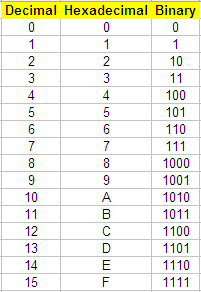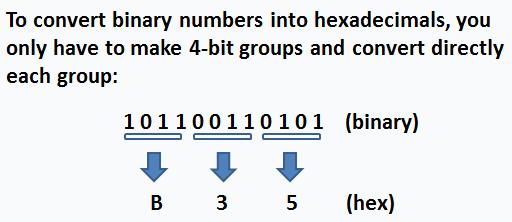Binary
to hexadecimal numbers: two solutions in Matlab
To convert a value from binary
to hexadecimal,
we first need
to know what a hexadecimal number is.
|
A major numbering system
used in digital systems is the
hexadecimal system, also named base 16. In this system, the numbers are
counted
from 0 to 9 and, since in base 16 we need 16 different symbols, decimal
numbers
10 through 15 are represented by letters A through F, respectively. So
we go
from 0 to F.
The following table shows
the meaning of all the symbols in
the hex (for short) numbering system. |
Table equivalents: decimal,
hexadecimal and binary numbers

To convert a value from binary
to hexadecimal, you merely
translate each 4-bit binary group to its hexadecimal equivalent. For
example,
the binary number 0011 1111 0111 1010 translates into the hex 3F7A
equivalent.
Solution 1.
In Matlab, we can go from
binary to
decimal, and then, from
decimal to
hexadecimal. We can embed one instruction into the other,
like this:
hex_str
= dec2hex(bin2dec(bin_str))
It’s
important to remember that both binary
numbers and hexadecimal
ones are treated
as strings
in Matlab.
So, we
can use this concept, like this:
bin_str
= '10001011110101'
hex_str
= dec2hex(bin2dec(bin_str))
Matlab’s answer is:
hex_str = 22F5
Solution 2.
Now, let’s say that we want to
explore how the binary groups
are separated to form the hex symbols and we want to manipulate our own
strings
(binary and hexadecimal).
We can develop a function
to translate the table shown
before. Our proposed method uses a switch-case
structure.

% Binary to Hexadecimal
conversion
function h =
b2h(b)
switch b
case {'0', '00', '000', '0000'}
h = '0';
case {'1', '01', '001', '0001'}
h = '1';
case {'10', '010', '0010'}
h = '2';
case {'11', '011', '0011'}
h = '3';
case {'100', '0100'}
h = '4';
case {'101', '0101'}
h = '5';
case {'110', '0110'}
h = '6';
case {'111', '0111'}
h = '7';
case '1000'
h = '8';
case '1001'
h = '9';
case '1010'
h = 'A';
case '1011'
h = 'B';
case '1100'
h
= 'C';
case '1101'
h = 'D';
case '1110'
h = 'E';
case '1111'
h = 'F';
end
Now, we have to call
the function for every 4-bit group of binary numbers. One possible
solution to
separate the binary number into 4-bit groups is shown here:
bin_str
= input('Enter
binary number: ', 's');
i =
length(bin_str);
n =
ceil(i/4);
for g = n :
-1 : 1
if i > 4
hex_str(g) = b2h(bin_str(i-3 : i));
i = i - 4;
else
hex_str(g) = b2h(bin_str(1 : i));
end
end
hex_str
Let’s
try it.
Enter
binary number: 101010
hex_str
= 2A
Enter
binary number: 110001011110101
hex_str
= 62F5
From
'Binary to Hexadecimal' to home
From
'Binary to Hexadecimal' to 'Matlab Programming'
Search Site

|




